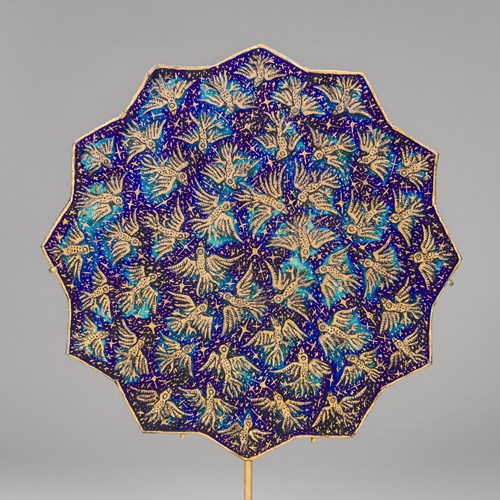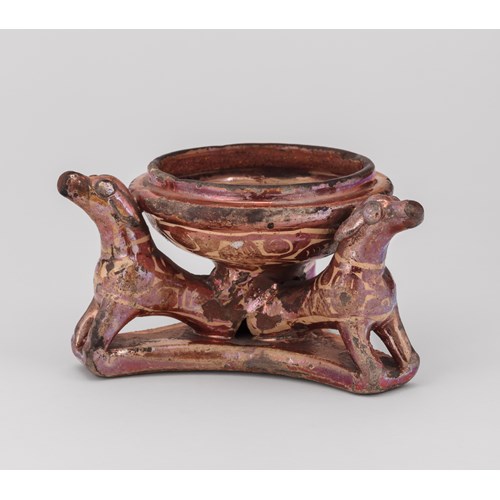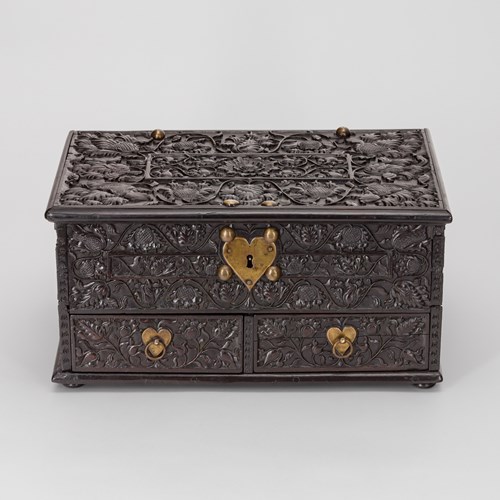Marketplace
Qajar Steel Mirror
Atop an elegant stand, this mirror of cusped circular form with a hinged door is made from silver and gold-damascened steel. No surface is left plain, with vegetal engravings filling the gaps between the symmetrically arranged gold arabesques. A similar decorative scheme can be observed on a Qajar mirror in the collection of the Cleveland Museum of Art (accession no. 1983.1111).
A border around the edge of the door covering the mirror is formed from cartouches holding Persian verses in praise of the mirror. They are garbled in places, suggesting that the craftsmen were copying a language which they did not understand. The mirror is one of the most recurrent symbolic features in Persian poetry, particularly the work of Hafez, representing the inner quality of a person.1 At the centre of the mirror a large Arabic inscription in gold damascene reads “the Sultan, son of the Sultan, Naser al-Din Shah”:
السلطان ابن السلطان ناصر الدين شاه
Naser al-Din Shah was the fourth Shah of Qajar Iran, reigning from September 1848 until his assassination in May 1896. He was a serious patron of the arts, leading them to flourish under his reign.2 Another mirror inscribed with his name is in the collection of the British Museum (accession no. 1967,0718.1). Unusually for Qajar metalware, the date cited on the object matches its production date. This suggests that it could have been made for use in the court of Naser al-Din Shah.
n.b. accession nos are clickable links
1 Davoudimoghadam, Farideh, and Eshaghi, Zahra. ‘Representation of the Mirror Motif in Hafez’s Lyric Poems’, Literature in the Iraqi Period 2.4 (2022). pp. 1-15.
2 Ekhtiar, Maryam, and Sardar, Marika. ‘Nineteenth-Century Iran: Art and the Advent of Modernity’, in Heilbrunn Timeline of Art History. New York: The Metropolitan Museum of Art, 2000.
A border around the edge of the door covering the mirror is formed from cartouches holding Persian verses in praise of the mirror. They are garbled in places, suggesting that the craftsmen were copying a language which they did not understand. The mirror is one of the most recurrent symbolic features in Persian poetry, particularly the work of Hafez, representing the inner quality of a person.1 At the centre of the mirror a large Arabic inscription in gold damascene reads “the Sultan, son of the Sultan, Naser al-Din Shah”:
السلطان ابن السلطان ناصر الدين شاه
Naser al-Din Shah was the fourth Shah of Qajar Iran, reigning from September 1848 until his assassination in May 1896. He was a serious patron of the arts, leading them to flourish under his reign.2 Another mirror inscribed with his name is in the collection of the British Museum (accession no. 1967,0718.1). Unusually for Qajar metalware, the date cited on the object matches its production date. This suggests that it could have been made for use in the court of Naser al-Din Shah.
n.b. accession nos are clickable links
1 Davoudimoghadam, Farideh, and Eshaghi, Zahra. ‘Representation of the Mirror Motif in Hafez’s Lyric Poems’, Literature in the Iraqi Period 2.4 (2022). pp. 1-15.
2 Ekhtiar, Maryam, and Sardar, Marika. ‘Nineteenth-Century Iran: Art and the Advent of Modernity’, in Heilbrunn Timeline of Art History. New York: The Metropolitan Museum of Art, 2000.
Plus d'œuvres d'art de la Galerie









_T638563782373054250.jpg?width=500&height=500&mode=pad&scale=both&qlt=90&format=jpg)